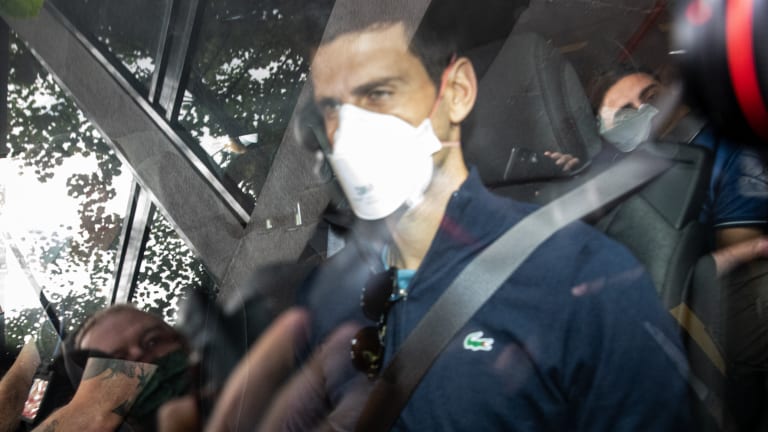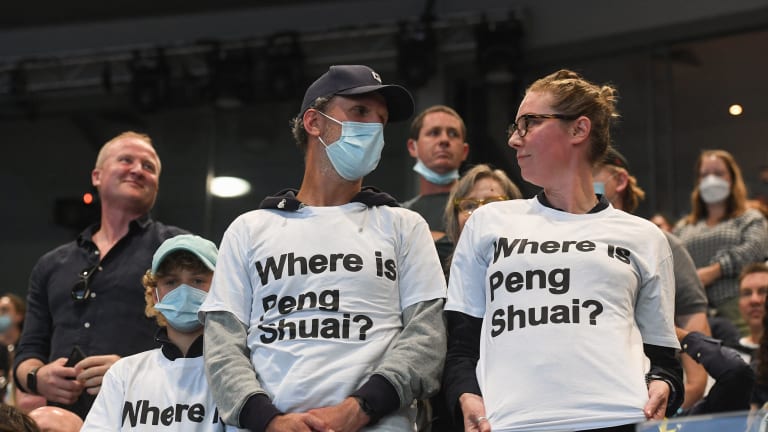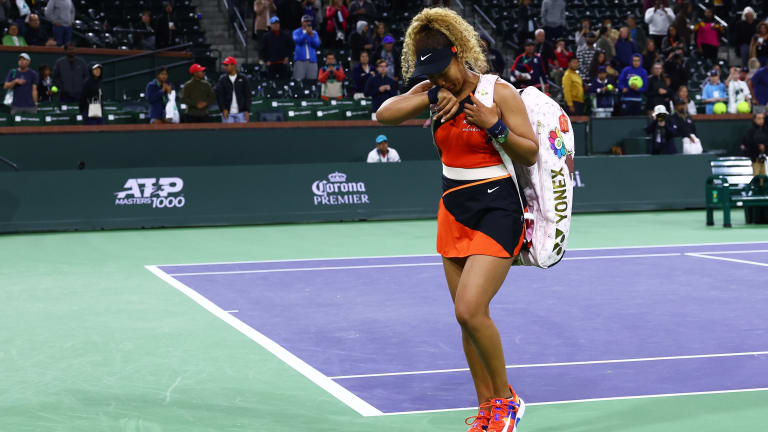Shades of ’68: From bans to bullies to bedlam—and beyond—2022 had it all
By Richard Osborn Dec 03, 2022The Process: How Jessie Irvine took her tennis game to the pickleball court
By Hannah Johns Nov 07, 2023A trip through California’s courts reveals plenty about pickleball’s inviting and intoxicating culture
By Joel Drucker Nov 07, 2023PBTV Primer: What to watch for when tuning into pickleball
By Dave Fleming Nov 07, 2023Alexandrova, Kudermetova to meet in all-Russian women's Den Bosch final
By Associated Press Jun 17, 2023Seeds Frances Tiafoe, Hubert Hurkacz, Lorenzo Musetti move into Stuttgart quarterfinals
By TENNIS.com Jun 14, 2023Stat of the Day: Gael Monfils battles to first tour-level win of injury comeback at Roland Garros
By John Berkok May 30, 2023Venus Williams to play first match since January at 's-Hertogenbosch grass-court tournament
By TENNIS.com May 30, 2023Three Chinese men play at French Open, the country's first male entrants in Paris since 1937
By Associated Press May 29, 2023Stat of the Day: Novak Djokovic is now 19-0 in his career in first-round matches at Roland Garros
By John Berkok May 29, 2023Shades of ’68: From bans to bullies to bedlam—and beyond—2022 had it all
Reflections on the most turmoil-filled year in tennis history.
Published Dec 03, 2022
Advertising
Nineteen sixty-eight was always the benchmark.
When it comes to chaos, of the political, racial, pop-cultural and even sporting variety, 1968 had it all. The war raged on in Vietnam. Students took to the streets in Berkeley, in Paris, in Mexico City. Draft cards were set alight outside the Democratic National Convention in Chicago. MLK was gunned down on a Memphis hotel balcony. Bobby Kennedy, too, was assassinated. Soviet tanks rolled into Prague. Olympians Tommie Smith and John Carlos raised their black-gloved fists to the sky in protest on the medal stand. Arthur Ashe ushered in tennis’ Open Era when he became the first Black man to lift the trophy in Forest Hills. The Beatles’ “Helter Skelter” signaled a menacing mood change, one that would inspire the likes of Charles Manson.
Richard Nixon won the U.S. presidency.
For many, it felt as if the world had been flipped on its proverbial backside.
Of course, these last few Covid-marred years have done their darnedest to compete: We’ve had a global pandemic, a racial reckoning reignited by George Floyd’s death in Minneapolis, an unsettling transfer of power in our nation’s capital, the Russian invasion of Ukraine, climate catastrophes, yet more gun violence in our schools, etc.
This chaotic churn has been felt in the tennisphere, too. Take 2022: Even without the madness of the past few years—the fan-less stadiums, quarantine bubbles, Novak Djokovic’s shock default and calendar-year Slam stall in Flushing Meadows, the ill-fated Adria Tour, Naomi Osaka’s media boycott, et al.—it’s been a year unlike any other.

Novak Djokovic, on his way out of Australia.
© Getty Images
Advertising
It began with a surreal should-he-or-shouldn’t-he-be-allowed-to-play conundrum, which saw the world’s top-ranked men’s tennis player, and the holder of a record nine Australian Open titles, not only barred from the year’s first major but confined to a Melbourne hotel-cum-detention center—and, ultimately, deported. Said Prime Minister Scott Morrison, the Australian people, who had endured some of the strictest lockdown protocols imaginable, had been through enough, and the unvaccinated defending champion Djokovic wasn’t entitled to any special exemptions.
The incident became daily fodder for headlines across the world, and called into question Australia’s treatment of its refugee community. (One man, a 24-year-old asylum seeker from Iran, claimed he had been held in limbo for nine years.) It also shone a spotlight on a widening Covid divide, Djokovic a sudden and unlikely anti-vax poster boy.
Nole’s supporters rallied in the Victorian capital. Serbian President Aleksandar Vucic called the proceedings a “witch hunt.” Srdjan Djokovic likened his son’s treatment to the crucifixion of Jesus.
With chief rivals Djokovic and the still-healing Roger Federer relegated to the sidelines, Rafael Nadal would snap their 20-20-20 Grand Slam deadlock, roaring back from two sets down against Daniil Medvedev to take the lead in the race for most men’s major singles titles. More fuel for the unceasing (and perhaps indeterminable) GOAT debate.
Months after she appeared to accuse a former high-ranking Chinese Communist Party official of coercing her into sex, former doubles No. 1 Peng Shuai briefly surfaced, giving an awkward, seemingly staged interview to a Singaporean newspaper. It wasn’t enough to convince us that she was safe, and WHERE IS PENG SHUAI? T-shirts began to pop up at the sport’s marquee events. Not all of the questioners were welcomed.

Ahead of the Australian Open women's singles final, 1000 "Where is Peng Shuai?" shirts were handed out by human rights activists to arriving fans.
© AFP via Getty Images
Advertising
Chris Evert disclosed a stage 1 ovarian cancer diagnosis. By mid-summer, the Hall of Famer would undergo two surgeries and six chemo treatments, back in the commentary booth after overcoming perhaps her toughest opponent yet. One of the sport’s most beloved figures, the snake-bit 2009 US Open champion Juan Martin del Potro, played his last match, aptly, on home soil in Buenos Aires. There wasn’t a dry eye in the house.
February saw Russian forces cross into Ukraine, onetime tour pros like Alexandr Dolgopolov and Sergiy Stakhovsky now toting rifles in lieu of tennis racquets in defense of their homeland. The Yastremska sisters—Dayana, 21, and Ivanna, 15—were whisked out of the country toward safety, leaving their parents behind. Elina Svitolina spoke of sleepless nights spent worrying about family and friends back home. Marta Kostyuk was stunned at the silence of her Russian tour counterparts.
“You don’t have to be into politics to know what’s going on, to know who invaded who, who is bombing who,” said Kostyuk. “What is very disappointing is that no Russian player came to see me. None have told me they’re sorry for what their country is doing to mine.”
While players and fans donned blue-and-yellow ribbons in a show of solidarity, and Russia’s Andrey Rublev scrawled NO WAR PLEASE overtures on courtside camera lenses, we were left to wonder when the senseless bloodshed would end.
(In an absurd twist of fate, the Muscovite Medvedev clinched No. 1—the first man not named Federer, Nadal, Djokovic or Murray to do so in nearly two decades—on Feb. 24, the VERY DAY Russia launched its offensive in Ukraine. “In these moments,” he offered, “you understand that tennis sometimes is not that important.”)
It’s a huge honor to take over this spot. I’m sure everyone can understand it comes with mixed emotions that it happens this week. Thank you to my wife, team, sponsors, friends, & everyone that has helped along the way. It’s a long journey and I look forward to the years ahead pic.twitter.com/YYGCHE4SBK
— Daniil Medvedev (@DaniilMedwed) February 28, 2022
Advertising
Alexander Zverev, already under the microscope amidst allegations that he abused his former girlfriend Olga Sharypova, pulverized his racquet on the umpire’s chair after a doubles defeat in Acapulco, for which he was booted from the event and slapped with a hefty fine.
In March, only weeks after becoming the first Australian to win her home Slam in 44 years, world No. 1 Ash Barty up and walked away from the sport, stunning the tennis world with the proclamation that she had “nothing more to give.” Like Swede Bjorn Borg before her, the universally-admired Barty was calling it quits in her prime, just 25 years old and the winner of two of the last three majors.
Djokovic, ruled out of both Indian Wells and Miami due to his vaccination status, announced that he and longtime mentor Marian Vajda were parting ways after 15 years and 20 major titles together. Another dynamic duo—Serena Williams and coach Patrick Mouratoglou, who combined for 10 of Williams’ Open Era-best 23 Slam titles—also split.
The four-time major champ and former No. 1 Osaka was reduced to tears in the California desert when some boorish fan bellowed: “NAOMI, YOU SUCK!” The 2018 BNP Paribas Open titlist promptly imploded, losing in short order, 6-0, 6-4, to Veronika Kudermetova. Afterward, she grabbed the microphone to remind fans that Indian Wells was where Serena and Venus Williams had been heckled back in 2001, an ugly incident that kept them away from the tournament for the better part of a decade-and-a-half.
“If you’ve never watched it, you should watch it,” said Osaka, who has openly (and bravely) discussed her mental health struggles. “I don’t know why, but it went into my head and it got replayed a lot. I’m trying not to cry.”

In being heckled at Indian Wells, Naomi Osaka recalled what Serena Williams experienced at the tournament decades earlier.
© Getty Images
Advertising
Osaka subsequently began seeing a therapist. She would leave IMG, too, launching her own sports agency, Evolve, and later jettison her coach and trainer. As if the endorsement magnet, the highest-paid female athlete on the planet, didn’t already have enough on her plate.
There were tears in Indian Wells and a mid-match storm-off in Miami for former No. 1 Victoria Azarenka. The Belarusian chalked it up to off-court stress.
Newly installed Roland Garros tournament director Amelie Mauresmo, one of the fiercest competitors the WTA has ever known, caught flak for suggesting that the men’s tour was currently more compelling than the women’s tour.
Holger Rune claimed fellow Scandinavian Casper Ruud taunted him in the locker room following their impassioned quarterfinal on Court Philippe-Chatrier. Jelena Ostapenko toppled a chair and walked off the court to a chorus of boos after squandering match points against Tatjana Maria in SW19, deeming her opponent “lucky.”
Simona Halep confided that she experienced an on-court panic attack: “I didn’t know how to handle it.” Pam Shriver made public details of what she says was a damaging relationship that began with her then-50-year-old coach when she was just 17. Wrote Shriver in The Telegraph, “Only after therapy did I start to feel a little less responsible. Now, at last, I’ve come to realize that what happened is on him.”
Many of us waxed poetic about Nick Kyrgios’ newfound focus and calm in Indian Wells, only to watch the enigmatic Aussie hurl his racquet toward a ballboy following his blockbuster 7-6 (0), 5-7, 6-4 quarterfinal loss to Nadal. Questioned about it afterward, Kyrgios dubbed respected New York Times reporter Matthew Futterman a “flop.”
It was hardly an isolated incident. Jenson Brooksby flung his racquet in frustration toward a ballboy in Miami. Irina-Camelia Begu’s racquet struck a young fan at Roland Garros. And Stefanos Tsitsipas fired a near-miss into the Centre Court stands at Wimbledon. The latter came during a heated third-round loss to none other than Kyrgios, a match fit for the Ringling Bros.
Advertising
“The circus was all him today,” said Kyrgios, who at 27 went on to reach his first major final.
“It’s constant bullying, that’s what he does,” said Tsitsipas, admitting that he tried to strike his opponent with the ball on more than one occasion. “He bullies the opponents. He was probably a bully at school himself. I don’t like bullies.”
“He’s that soft, to say I bullied him. That’s just soft,” Kyrgios shot back. “We’re not cut from the same cloth. I go up against guys who are true competitors.”
Of course, this was no run-of-the-mill Wimbledon. In an effort to “limit Russia’s global influence through the strongest means possible,” the All England Club banned the already flag-less Russian and Belarusian players, including the reigning No. 1 Medvedev. It marked the second time in 2022 that the top-ranked man was locked out of a major. In turn, the ATP and WTA tours pulled the rankings points, in essence rendering the sport’s most storied event a glorified exhibition, albeit a monied one. The WTA went so far as to levy fines against both the All England Club and Britain’s Lawn Tennis Association.
“It’s just a damn shame that it’s come to this,” said John McEnroe.
Advertising
Djokovic would claim his seventh Wimbledon title, and 21st major overall—only to drop to No. 7 in the rankings. Go figure. And, fittingly, despite the AELTC’s sanctions, a Russian-born player, Elena Rybakina, now representing Kazakhstan, won the women’s title. Of course she did.
And we were barely into July.
Russia’s Dasha Kasatkina courageously emerged from the closet, simultaneously denouncing Vladimir Putin’s war. The tours’ China swings were nixed (again). And the year-end Grand Slam didn’t stray from the script: Djokovic once again found himself on the outside of a big-stakes event, the US Open, unwilling to undergo the jab and therefore unable to enter the country, his record-book pursuits back on hold.
In his absence, a new world order took shape. The resulting power vacuum saw no less than five players have a shot at No. 1. In the end, it was the first-time Grand Slam titlist Carlos Alcaraz of Spain, all of 19, who seized the moment, winning three consecutive five-setters (one lingering until 2:50 a.m.) en route to becoming the youngest No. 1 in the history of the ATP rankings.
Advertising
Only weeks away from her 41st birthday and ranked an unaccustomed No. 605, Serena Williams played what appears to be the final match of her illustrious career, still one Slam short of Margaret Court but in the minds of so many long the GOAT. Fittingly, the match was played on the very same court where she captured her first major title as a beaded-and-cornrowed teen back in 1999. Her ‘evolution’ away from the sport prompted sellout after celebrity-filled sellout in Arthur Ashe Stadium and record TV viewership worldwide. Jessica Pegula, now the top-ranked American woman, perhaps put it best when she said, “It’s just hard to picture tennis without her.”
And just as we were beginning to think the year couldn’t possibly provide any more disorder came news that Federer—he of the Baryshnikovian athletic grace, of the transcendent fame that spawned allegiant armies of ‘RF’ hat wearers from Basel to Beijing, of the record eight Wimbledon titles, unequaled 237 consecutive weeks at No. 1, etc.—was retiring, injuries having taken their cruel toll. It was news we knew was coming yet somehow couldn’t prepare ourselves for. Wasn’t it just yesterday that he was falling to his knees on Centre Court, having vanquished the great Pete Sampras, the baton officially passed?
Twenty twenty-two may not be 1968, but it will surely stand as the most chaotic year in the annals of tennis.
Advertising
In some ways, it felt like one long, 12-month heavyweight prizefight. The hooks, the jabs, the unforeseen body blows, they just kept on coming. Compelling though it was, at times we had to look away. Somewhere Rocky Balboa and Apollo Creed, bone-weary and bloodied, are hugging it out in the ring, each reliant upon the other to remain upright.
“Ain’t gonna be no rematch.”
Thank goodness. I don’t think we could handle another like it.